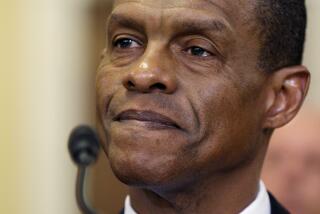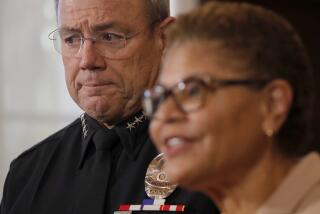Adm. Thomas Moorer, 91; Head of Joint Chiefs in Vietnam War Years
- Share via
Adm. Thomas H. Moorer, chairman of the Joint Chiefs of Staff during crucial years of the Vietnam War who advocated aggressive force to win the conflict, died Thursday after a stroke at the National Naval Medical Center in Bethesda, Md. He was 91.
A tall, soft-spoken and stern Southerner, Moorer was considered a master strategist, and he occupied a series of increasingly prominent positions from the beginning of major U.S. military involvement in Vietnam until its end.
He was commander in chief of the Pacific Fleet during the disputed Tonkin Gulf clash between U.S. and North Vietnamese sea forces in 1964. The incident led Congress to authorize President Johnson to take all measures to protect U.S. forces and “to prevent further aggression.” This gave Johnson free rein to bomb North Vietnam and commit U.S. ground forces to the conflict in South Vietnam.
Moorer, who believed that success in war depended on the use of force, supported these measures.
From 1967 to 1970, he was chief of naval operations, the Navy’s top officer. As the war continued, he grew frustrated with the executive branch’s strategy of containment of Communist forces in the North instead of total victory. He and other military officials felt that the enemy would crumble only with a convincing show of force. He spent years trying to persuade officials to mine Haiphong Harbor, a supply route for Hanoi; the mining took place in 1972.
By then he had become chairman of the Joint Chiefs, the nation’s top military officer. He kept a relatively low public profile during his two-term tenure, which ended with his retirement in 1974. Among the issues, conflicts and resolutions he faced were arms-limitation talks with the Soviets and the Arab-Israeli War of 1973.
Decades later, Moorer again figured in the news because of the war. He had been a source for a much-disputed 1998 CNN report on Operation Tailwind. The report charged that U.S. forces had used a lethal nerve gas on American defectors in Laos during the war.
CNN producers said Moorer had confirmed the sarin story, but the admiral later denied independent knowledge of use of the gas. CNN retracted the report, fired two producers and reprimanded the on-air reporter, Peter Arnett. The network paid Moorer an undisclosed sum.
Thomas Hinman Moorer was a native of Mount Willing, Ala. When he was a boy, his interests were mechanical engineering and military science. At 15, he was his high school class valedictorian.
Because of his age, he had to wait two years before gaining admittance to the U.S. Naval Academy in Annapolis, where he was a varsity football lineman. He graduated in 1933 near the top of his class. He completed flight training at Pensacola, Fla., in 1936 and was stationed at Pearl Harbor when the Japanese attacked on Dec. 7, 1941.
Moorer went with his squadron to the South Pacific as part of the effort to stem the Japanese advance toward Australia. On a reconnaissance mission, he and his crew were shot down by nine Japanese fighters, and the future admiral was wounded in the hip by shrapnel. The plane was in flames and speeding toward the water at 100 mph, but he managed to land the craft after bouncing three times on the water’s surface.
Rescued by a Philippine freighter, the crew was again besieged within minutes when Japanese dive bombers attacked the ship. Moorer led those on board to two lifeboats and guided them to an uninhabited island. He drew a large SOS sign in the sand and was spotted two days later by Australian fliers. For his actions, he received the Silver Star and Purple Heart.
After the war, he attended the Naval War College and held a succession of sea command posts and prestigious desk assignments. He was aided by Adm. Arleigh Burke, the brilliant and ambitious war hero whom Moorer served as assistant chief of naval operations in the late 1950s.
Moorer was promoted to rear admiral in 1958, reportedly becoming, at 45, the youngest officer at the time selected for that rank. He made vice admiral in 1962 and full admiral two years after. Time magazine called him “America’s fastest-rising sailor.”
In August 1967, Moorer became the 18th chief of naval operations. The next January, the lightly armed spy ship Pueblo was seized by the North Koreans in what they claimed were their territorial waters. The commander and crew were held and tortured for 11 months before their release.
Moorer pressed for the court-martial of Cmdr. Lloyd Bucher, but that did not occur. Bucher was severely criticized by a Naval Court of Inquiry, however, for having surrendered without firing a shot.
Moorer also faced concerns about proper war strategy in Vietnam and during a time of Soviet military proliferation. On those issues, he urged a determined approach: putting more troops in Vietnam on the advice of front-line commanders and supporting new technologies that made for quieter nuclear submarines.
He was reappointed chief of naval operations by President Nixon in 1969 and named chairman of the Joint Chiefs the next year. Moorer told an interviewer that the executive branch relied on civilian advisors more than its military ones, leading to limitations in his power that not many in the public grasped.
He said there were those who felt that the military was too weak to exert proper control over the war and those who believed that it had too much influence over civilian authority. “Both of these allegations,” he said on his retirement, “are nonsense in its purest form.”
He added that, in reflection, World War II had largely defined his perspective. After being shot down, sunk and finally rescued in the South Pacific, he vowed to himself and his comrades that he would consider all crises thereafter to be anticlimactic.
Survivors include his wife of 68 years, Carrie Foy Moorer of Bethesda; four children; two brothers; 10 grandchildren; and two great-grandchildren.
More to Read
Sign up for Essential California
The most important California stories and recommendations in your inbox every morning.
You may occasionally receive promotional content from the Los Angeles Times.










